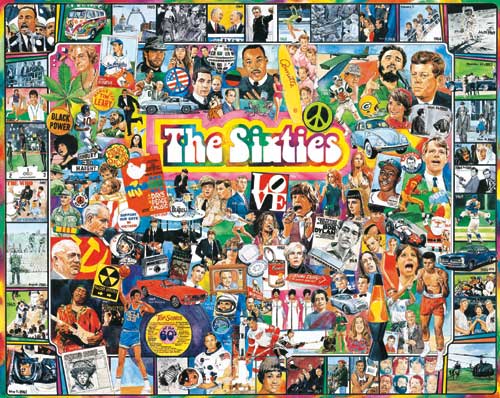
From Entertainment Weekly's TV Review, "Making Sense of the Sixties (1991 - 1991)," reviewed by Ken Tucker, on 18 January 1991 -- In its opening moments, Making Sense of the Sixties seems like a parody of PBS documentaries, dealing with the decade as if it were the ancient history of a foreign country. But then you realize that's exactly what the '60s in America are. So much of this history has been distorted or hidden away over the past 30 years that everything has to be explained slowly, patiently: the Vietnam War and the popular resistance to it; hippies and LSD; rock music as a cultural force, not a marketing tool; Students for a Democratic Society (SDS) and the Black Panthers; the political consequences of the assassinations of John F. Kennedy and Martin Luther King Jr.
The six-part series — two parts will be shown each night — offers lots of vintage film clips, period music (Phil Ochs, the Mothers of Invention), and contemporary testimony from '60s witnesses, both famous and obscure. Thus Vietnam vet and film director Oliver Stone asserts that the underlying purpose of the decade was ''to test and enjoy the limits of life.'' Ron Sandes, a % California union leader, comments that '60s protests and the hippie lifestyle were ''totally unrealistic to anyone who was a blue-collar worker.'' Music critic Greil Marcus talks about the way the best pop music of the era ''broke all limits of politeness'' and inspired its listeners to say to themselves, ''Of course. Yes, I've been waiting all my life for this, and I never knew it.''
Making Sense of the Sixties, overseen by executive producers Ricki Green and David Hoffman, does a good job of describing the roots of the decade's upheavals — the unprecedented prosperity of the baby-boom generation and the world conditions that gave rise to the American involvement in Vietnam. The series is also admirably unconcerned about contradicting itself. For example, while the narration describes LSD in harshly negative, melodramatic terms (''the most potent psycho-chemical ever invented,'' and worse), we also hear many comments from a New Mexico roofing contractor named Terry Northway, who describes himself as having been ''a discerning acidhead.'' Northway credits his acid trips with making him what he is today: a ''happy born-again Christian.'' Hey, what do you say to that, Jerry Falwell?
At its best, Making Sense captures the messy, idealistic, anything-can- happen feelings that pervaded the '60s. At its worst, it has a few glaring flaws. The rise of the women's movement is given amazingly little consideration, and few distinctions are made between wildly diverse political efforts such as the Berkeley Free Speech Movement, SDS, and the Weather Underground, which are lumped together and pretty much dismissed in one episode.
In its overriding attempt to make sense of the '60s, the series tends to oversimplify. ''Tonight,'' journalist-narrator Carol Rissman says at the start of the third episode, ''we'll deal with two rebellions separately: first the cultural, then the political.'' But the whole point of the decade was that you couldn't separate those two things; a few people interviewed here even mention the then-popular slogan, ''The Personal Is Political.''

Making Sense is also a little sloppy. The Rolling Stones' December 1969 concert at Altamont (the infamous bummer in which one audience member was killed, and others assaulted, by some members of the Hell's Angels) is made to seem as if it happened before Woodstock, which took place four months earlier. And during a brief mention of the gay rights movement and the American Indian Movement, Rissman notes the participants' exhilaration: ''That feeling came to be called empowerment,'' says Rissman. ''It meant taking control of your ownlife.'' Sorry, Carol. No one used ''empowerment'' that way in the '60s — it's strictly a '90s cant word.
By all means, watch Making Sense of the Sixties. But if you really want to try figuring out the decade, go to the library and find all the stuff the show leaves out. Read Emmet Grogan's Ringolevio, the best hippie autobiography; read James Miller's Democracy Is in the Streets, a clear-eyed history of SDS; read Murray Kempton's The Briar Patch, a study of the Black Panthers and the American judicial system of that era. Whether on television or in books, this is ancient history with a lot to tell us about the way we live now. B+ (source: Entertainment Weekly)
Episode 2: We Can Change the World -- The Early 1960s - A Time Of Innocence
Episode 2: We Can Change the World -- The Civil Rights Movement was Glorious


This comment has been removed by a blog administrator.
ReplyDeleteThis comment has been removed by a blog administrator.
ReplyDeletepalm angels
ReplyDeletejordan outlet
jordan travis scott
golden goose
supreme clothing